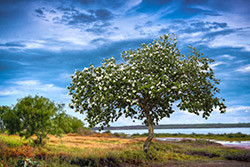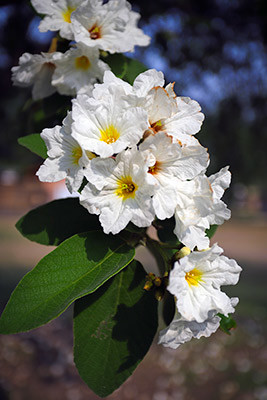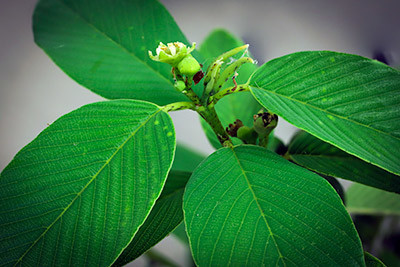 Written by Colleen Hook, Quinta Mazatlán
Written by Colleen Hook, Quinta Mazatlán
Flowers bring joy—and your backyard can deliver flowers to you daily when you plant a Wild Olive tree, also known as the Anacahuita (pronounced ANA-COW-EAT-A). The citizens of Nuevo Leon, Mexico, honor this beautiful tree as their state flower.
 Historically, the Wild Olive grew no further north than the Rio Grande Valley, but now is a popular landscape tree around the state. Botanically, the “olive” is not related to the types of olives people eat. However, birds and mammals enjoy the wild “olive”.
Historically, the Wild Olive grew no further north than the Rio Grande Valley, but now is a popular landscape tree around the state. Botanically, the “olive” is not related to the types of olives people eat. However, birds and mammals enjoy the wild “olive”.
The gorgeous white flowers primarily bloom from March to June, but can be seen throughout the year. The nectar in the flowers attract hummingbirds—so these little fellows are not just attracted to red flowers. Butterflies and bees are also fond of the white flowers.
When finding a home for your Wild Olive (also called Mexican Olive and Texas Olive), consider the following:
1) Native evergreen typically reaches 15-feet high
2) Tree has a 10-foot spread
3) Flowers fall on the ground giving a snow-like appearance so you may stay away from ponds and sidewalks
4) Once established, the tree lives off Valley rain
5) The Wild Olive has a natural bonsai like shape so no pruning required
 Treat yourself and wildlife to a bouquet of flowers year round and plant a Wild Olive in your landscape. For more information on native plants and animals of the Rio Grande Valley, visit the Quinta Mazatlán website, www.quintamazatlan.com.
Treat yourself and wildlife to a bouquet of flowers year round and plant a Wild Olive in your landscape. For more information on native plants and animals of the Rio Grande Valley, visit the Quinta Mazatlán website, www.quintamazatlan.com.
PHOTO CREDIT: Quinta Mazatlan World Birding Center, Photographer Jaime Villarreal














